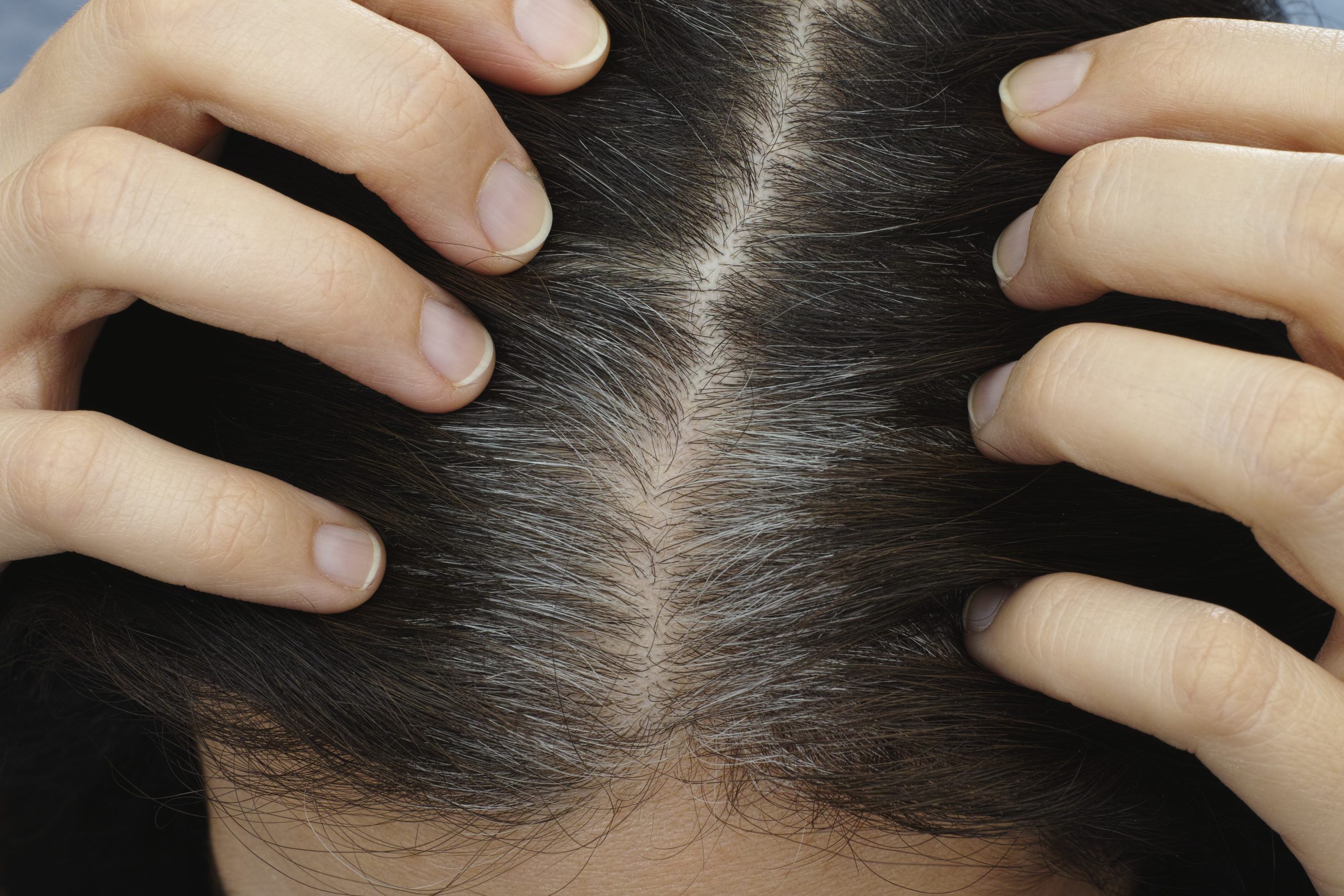
Page Contents
Everyone knows that your hair turns gray as you age. However, not everyone knows why. Understanding why your hair turns gray is the first step to preventing loss of hair color; surprisingly, there is a significant amount of information on this topic.
If you want to stop your hair from turning gray, it’s time to dive right in.
Your Hair Cycles For Gray Hair
Hair grows in a specific natural cycle, and it is continuously shifting between each cycle. Each time your hair completes one process, it loses some of its melanin and wears on the hair follicle. Even when your hair is gray, the cycle will continue.
Inside your hair follicle, you have different cells that work together to makes a strand of your hair. Some cells, which are at the root of your hair follicle, gives your hair color thanks to melanin.
As your hair continues to grow, older cells are pushed out of your hair follicles; therefore, your hair grows longer. We commonly associate hair with this cycle, but we are missing some more critical aspects. After the growth cycle, you enter a stage where your hair falls out.
Each individual hair enters this stage at differing times, explaining why we don’t lose all of our hair at once. When you brush your hair, roughly the same amount falls out a day. Finally, your hair follicles rest for a while before starting a new cycle.
Each hair cycle uses up a little bit of melanin that your hair follicles store. Although your hair follicles can make new melanin, it’s easier to pull from what is already stored. Therefore, when you run out of melanin, your hair begins to lose color.
This cycle also means that your hair begins to grow slower. With a lack of melanin, the cells in your follicles are not pushed out as fast, resulting in slower hair growth.

Facts To Know About Gray Hair
Gray hair is an unavoidable part of aging, but there is a lot more to it than that. For starters, certain things can age your hair gray faster than it needs to. Most of these factors can be avoided, but only if you first know what they are.
Genetics
One of the largest factors of graying is genetics. This should come as no surprise, considering just how much of your physical features are determined by genetics. This includes everything from your eye color to your facial features and, of course, your hair color.
Take a look at when your parents started going gray. Since genetics are only one of the factors that control when you go gray, the timeline might not look identical for you. Still, it is highly likely that you will gray around the same age as your parents.
You can also analyze your ethnicity to determine graying. Different people from different nationalities have a higher tendency to gray at certain ages. Additionally, specific hair colors tend to gray sooner as well.
For example, Caucasian redheads are the most likely to gray young. Firstly, we know that Caucasians gray at a younger average age than those with darker features. Secondly, red hair runs out of melanin quicker than any other hair color.
Regardless, half of the population is going gray by the time they are fifty years old. If you are still worried about when you will go gray, fifty is a good number to remember.
Lifestyle
Surprisingly, there is a long list of lifestyle factors that can potentially affect your hair. Bad habits, including drinking or smoking, is bad for you; however, these are factors you have influence over!
Even if you don’t smoke, your hair can still be affected by secondhand smoke. Nearly one out of every four non-smokers have some byproducts of nicotine in their blood. Smoking can make you gray much sooner than the average individual; it is something to avoid for that reason alone.
Another factor is your diet. Your hair needs proper nutrients to both grow your hair and produce melanin. When your hair is deficient, it wears out the follicles faster, which results in gray hair.
For example, junk food, including chips or sodas, will never be a proper source of vitamins and minerals. Instead, you should be eating plenty of fresh fruits and vegetables if you want to keep your melanin.
Taking vitamins is not a sufficient replacement for eating healthy. Once you begin eating a healthy diet, add probiotics and fermented foods to help pull out those minerals.
Health

Taking care of your health plays a large role in your hair, including when it turns gray. The healthier you are, the better your body will take care of your hair. On the flip side, if your body is deficient in nutrients and weight, your body will pull from your hair.
Medical problems can directly affect your hair, including your melanin. Thyroid problems, pituitary gland disorders, autoimmune diseases, and various other medical issues are known to turn your hair gray.
Even if you are treating a disease or disorder, your medications can affect your hair. These side effects can cause your hair to fall out, and in some cases, go gray. Chemotherapy is an obvious example of a treatment that affects your hair.
Regardless of your current health situation, boosting your immune system is a terrific idea. A stronger immune system means that you rarely get sick; therefore, you will have healthier hair.
Hair Damage
Whether you realize it or not, much of your daily routine can damage your hair. Did you know that most hair products are laden with chemicals, even if they are pronounced organic?
Anytime your hair gets damaged, your hair growth cycle will speed up. The sooner your hair falls out, the sooner you will burn through stored melanin. Avoiding damage to your hair is a crucial component to prevent gray hair.
Some hairstyles you enjoy could be pulling out your hair! Taking up and down your hair, especially in tight styles, often damages your hair. Not only will your hair fall out, but it will damage the follicle. If this style is repetitive, you will do long term damage to your scalp.
Dyeing your hair also causes significant damage. It can actually be counterproductive to dye your hair gray! In reality, you are simply speeding up the process of turning gray.
Exposure to sunlight can also damage your hair. It is crucial to protect our skin from the sun, so we turn to sunscreen. However, our hair needs protection, too! Wearing a hat is a great way to protect your hair from UV rays.
Additionally, washing your hair too much can strip your hair of its natural oils and cause damage. On the other hand, when you are exposed to chlorine or other harsh chemicals, those need to be washed out as soon as possible.
Stress
Stress is both mental and hormonal. If you are not dealing with stress properly, your hormones will be out of balance. These hormones can affect your body in various ways.
Stress can speed up your hair cycles, causing more hair to fall out; it also increases the amount of natural hydrogen peroxide in your blood. Although hydrogen peroxide is good in small amounts, large amounts will attach to your hair follicles and bleach your hair!
Keep in mind that stress is not always associated with mental exhaustion, but rather exposure to chemicals, junk food or, surprisingly, too much experience.
Tips To Transitioning To Gray Smoothly
Many people feel self-conscious and hyper-aware when they begin transitions to gray hair; however, this process doesn’t have to be challenging. Let’s first look at your part line to ease the transition.
Part lines clearly show the individual strand of your hair, and in turn, how much hair is going gray. Start by wearing pulled-back hairstyles to hide your part line. Braids are also a great way to hide gray strands. You could also vary where your part lays if some sections of hair have not turned gray yet.
Additionally, straight hair makes it easy to see gray hairs, so try to go for waves or curls; don’t use heat for this process! Overnight hairstyles are a great way to boost texture, prevent damage and hide those pesky grays.
When you have too many grays for the above options, highlights are your next best bet. Streaks of light colors in your hair can hide gray hairs entirely! Even if you did not dye your gray hair, those hairs will not look out of place or draw attention. Highlights look great and feel great!
Once your hair fully transitions, you have the option to dye your hair entirely. Going for a lighter color is a great way to hide the grays when growth begins. Keep in mind that dying your hair gray is currently a trend. Whether you rock your natural color or choose to dye your hair, both options are stunning (and popular)!
Final Thoughts
Now that you know what makes your hair transition to gray, you should have a good idea about preventative measures. After all, gray hair tends to be coarser and less manageable; you need to know the “whys” before treating it.
Without melanin, your hair is more susceptible to damage. As you transition to gray hair, it’s essential to take some time to research how you can better your hair during this process.
Going gray can take a bit of getting used to, especially when you are trying to care for and style it. Hair masks, shampoos and natural treatments are just a few ways you can achieve healthy gray hair. Although adjusting to gray hair requires deviation from your routine, learning how to manage healthy gray hair is worth all of the effort!







